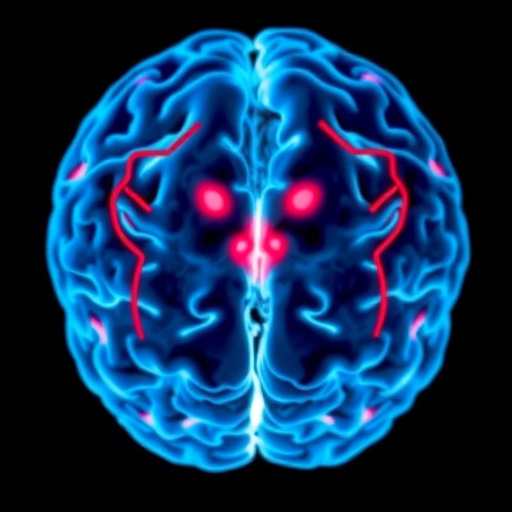In a compelling cohort study published in BMC Geriatrics, researchers Lu, H., Li, R., and Li, J. explore the intricate association between cholinergic white matter hyperintensity volume and cognitive decline, alongside the onset of dementia in older adults. This significant research adds to the growing body of literature aiming to unravel the complex interactions between age-related brain changes and cognitive health, highlighting the role of specific brain structures and functions that may either protect against or contribute to cognitive deterioration.
Cholinergic white matter hyperintensities (WMHs) are disturbances in the brain’s white matter that can be detected through advanced imaging techniques. These hyperintensities are often associated with vascular damage and neurodegenerative changes that occur as people age, despite their subtlety in clinical presentation during early stages. Understanding their impact on cognitive function is crucial, especially given the global rise in dementia cases tied to an aging population.
The cohort studied comprised older adults who underwent a thorough assessment involving neuropsychological tests and neuroimaging. This rigorous methodology ensured that the data collected was robust and reflective of real-world conditions. The approach fosters a comprehensive understanding of the mechanisms linking WMHs and cognitive functions. The role of cholinergic pathways in learning and memory underscores the importance of investigating these hyperintensities, which may disrupt these neural circuits, consequently leading to cognitive decline.
In the initial phases of the study, researchers meticulously categorized participants based on their WMH volume, using high-field magnetic resonance imaging (MRI). The findings indicated a clear pattern: increased cholinergic WMH volume was significantly correlated with accelerated cognitive decline. Participants exhibiting higher volumes of these hyperintensities displayed a more rapid deterioration in neurocognitive tests, prompting a need for further investigation into potential underlying mechanisms of this relationship.
What makes this research particularly noteworthy is its implications for preventive strategies in older adults. By identifying cholinergic WMH as a contributing factor to cognitive decline, health professionals may be able to develop targeted interventions. Therapeutic strategies could be designed to mitigate the effects of these hyperintensities, possibly slowing the onset of cognitive impairment and dementia. This paradigm shift would not only enhance the quality of life for older adults but also potentially reduce the economic burden associated with dementia care.
The cohort’s longitudinal design allows for the observation of changes over time, providing insights not only into the current state of cognitive function among participants but also into the trajectories they follow. Such data is invaluable, as it can reveal critical windows for intervention when cognitive decline is still in its nascent stages. The findings underscore the need for routine screenings and early diagnostic measures based on the presence of cholinergic WMHs, suggesting that these imaging findings should become part of the standard assessment toolkit for older adults.
Moreover, this research stirs up a discussion around the mechanisms driving cholinergic WMH formation. Hypothesizing what aspects of lifestyle or health contribute to the development of these hyperintensities is an intriguing avenue for future research. Factors like hypertension, diabetes, and lifestyle choices, including diet and physical activity, could be closely examined in relation to WMH formation. Identifying modifiable risk factors would be critical in paving the way for preventative approaches in geriatric health care.
Importantly, the findings echo broader concerns within geriatric medicine regarding the need for a multidisciplinary approach to tackling cognitive decline. Collaboration between neurologists, geriatricians, psychologists, and occupational therapists could foster a comprehensive care model that incorporates cognitive rehabilitation, lifestyle modifications, and ongoing monitoring. The study by Lu et al. can be a foundational reference point for developing such integrated care strategies, reinforcing the notion that brain health is multifaceted.
As the prevalence of dementia increases globally, research like this not only heightens awareness but also energizes a response in public health policy. Policymakers may be prompted to invest in preventive measures and health education initiatives aimed at older populations. By steering focus towards the implications of cholinergic WMH volume, strategic interventions can be developed, ranging from community-based programs promoting cognitive engagement to educational campaigns emphasizing cardiovascular health.
Finally, the longevity of this research’s impact will rely on its ability to stimulate further studies. It raises essential questions around whether similar associations hold true across diverse populations and different age ranges. The nuances of genetic predispositions, environmental factors, and the varying impacts of healthcare systems could yield diverse outcomes worth exploring. Such inquiries could lead to more tailored and effective strategies for managing cognitive decline, ideally delaying the onset of dementia and enhancing the overall well-being of older adults.
In conclusion, the study by Lu, H., Li, R., and Li, J. opens multiple avenues for enriching our understanding of cognitive health in aging populations. By delving into the connection between cholinergic white matter hyperintensities and cognitive decline, this cohort study lays the groundwork for vital future research. Its implications speak profoundly not only to individual health care strategies but also to broader public health initiatives aimed at combating dementia and promoting cognitive vitality well into older age.
Subject of Research: Associations of cholinergic white matter hyperintensity volume with cognitive decline and incident dementia in older adults.
Article Title: Associations of cholinergic white matter hyperintensity volume with cognitive decline and incident dementia in older adults: a cohort study.
Article References:
Lu, H., Li, R., Li, J. et al. Associations of cholinergic white matter hyperintensity volume with cognitive decline and incident dementia in older adults: a cohort study.
BMC Geriatr 25, 768 (2025). https://doi.org/10.1186/s12877-025-06447-x
Image Credits: AI Generated
DOI: 10.1186/s12877-025-06447-x
Keywords: cholinergic white matter hyperintensity, cognitive decline, dementia, older adults, cohort study, brain health, neuroimaging.
Tags: advanced imaging techniques for WMHsage-related brain changesbrain structure and cognitive functioncholinergic white matter hyperintensitycognitive decline and agingcohort study on dementiadementia risk in older adultsmechanisms linking WMHs and cognitionneuroimaging in dementia studiesneuropsychological testing in elderlyrole of cholinergic pathways in cognitionvascular damage and brain health





